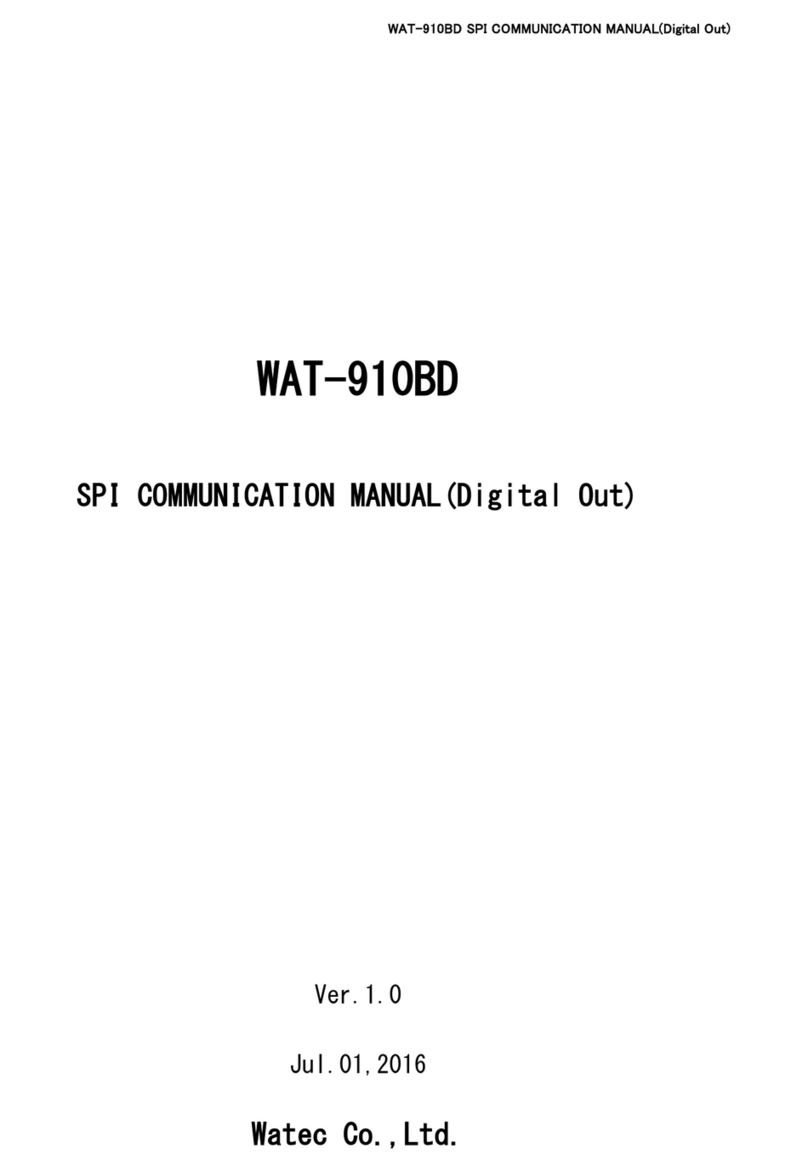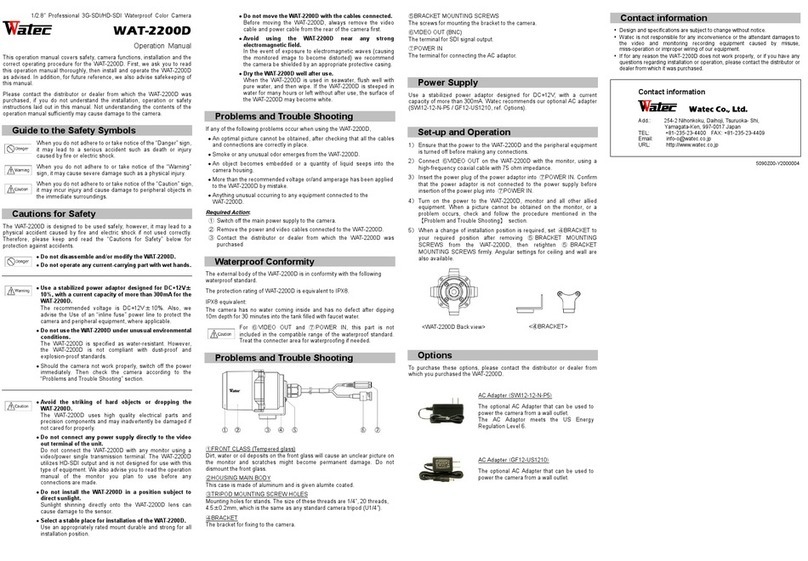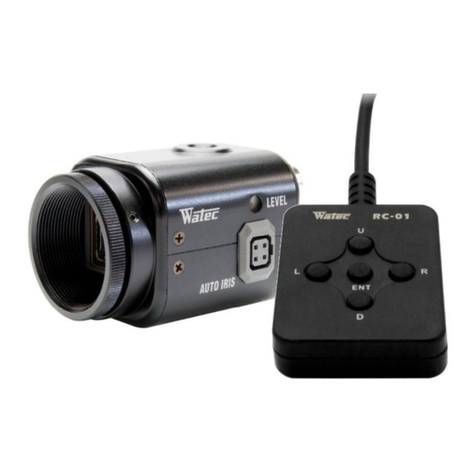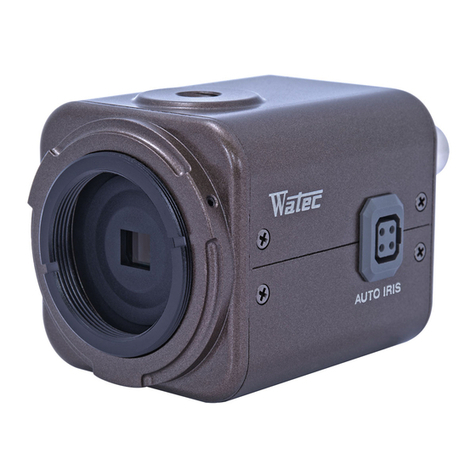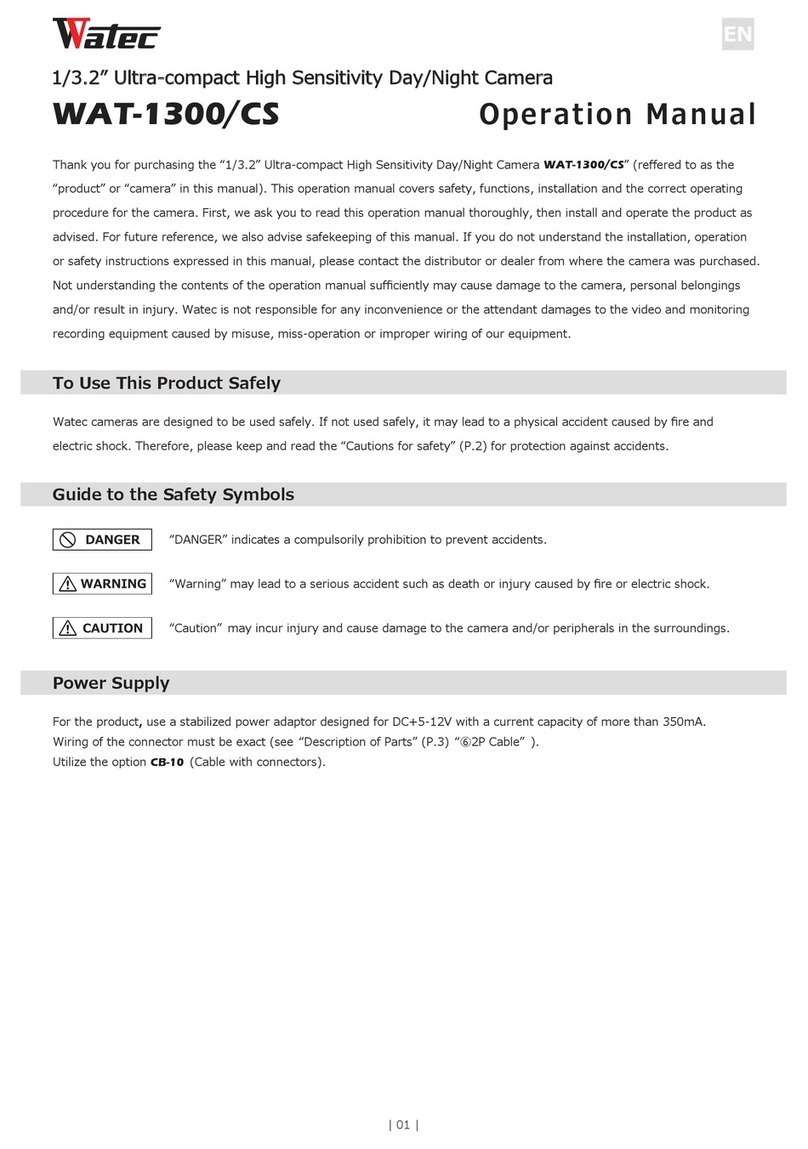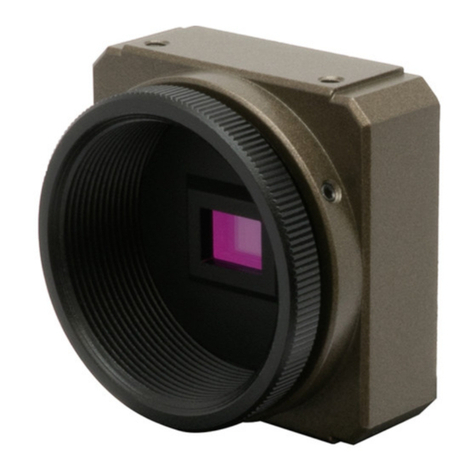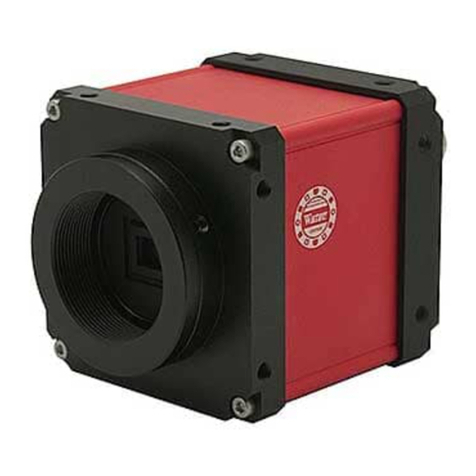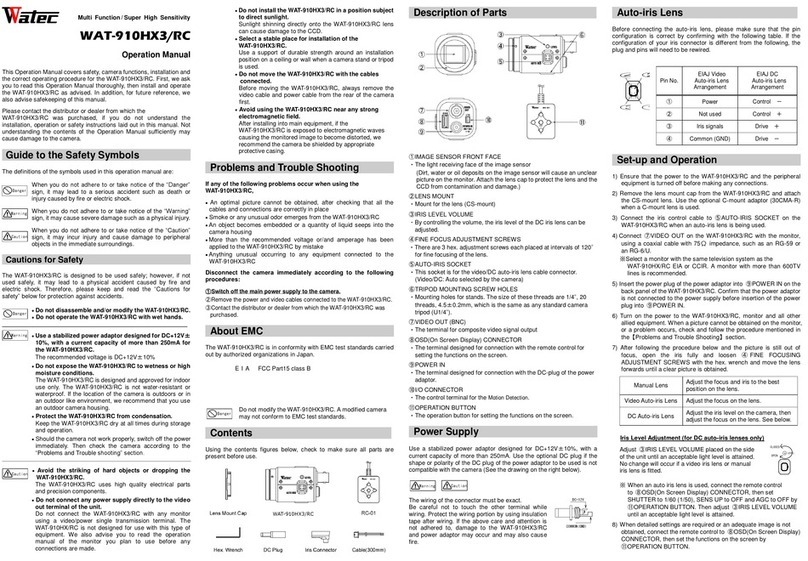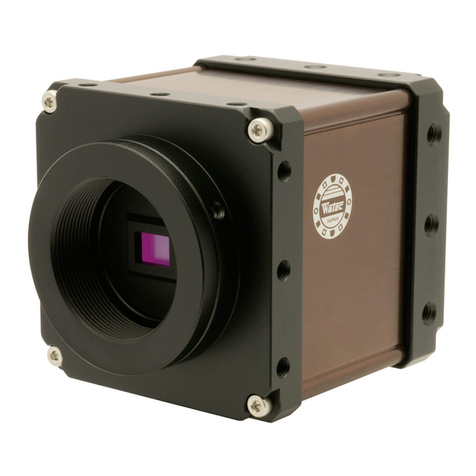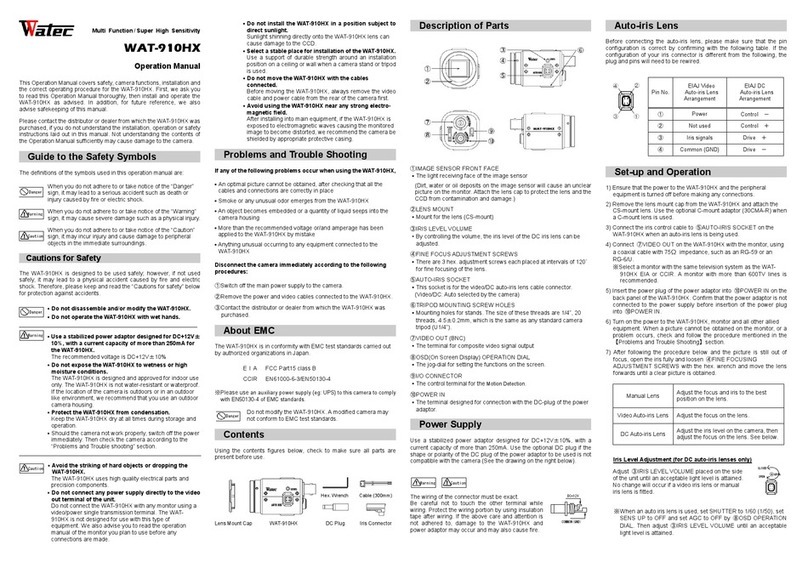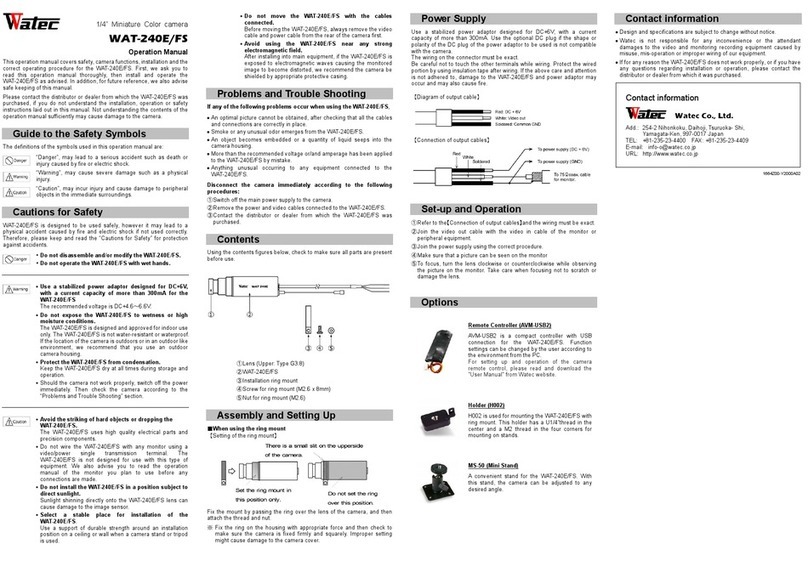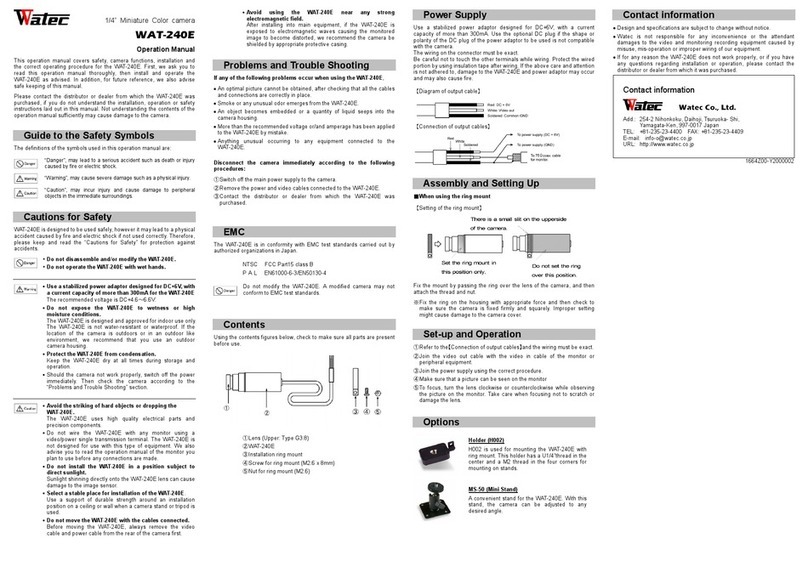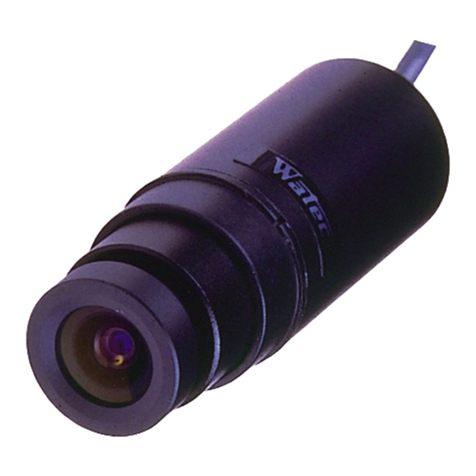
Day
&
Night Camera
WAT-232S
Operation Manual
This Operation Manual covers safety, camera functions, installation and the
correct operating procedure for the WAT-232S. irst, we ask you to read this
Operation Manual thoroughly, then install and operate the WAT-232S as advised.
In addition, for future reference, we also advise safekeeping of this manual.
Please contact the distributor or dealer from which the WAT-232S was
purchased, if you do not understand the installation, operation or safety
instructions laid out in this manual. Not understanding the contents of the
Operation Manual sufficiently may cause damage to the camera.
Guide to the Safety Symbols
The definitions of the symbols used in this operation manual are:
When you do not adhere to or take notice of the “Danger” sign, it
may lead to a serious accident such as death or injury caused by
fire or electric shock.
When you do not adhere to or take notice of the “Warning” sign, it
may cause severe damage such as a physical injury.
When you do not adhere to or take notice of the “Caution” sign, it
may incur injury and cause damage to peripheral objects in the
immediate surroundings.
Cautions for Safety
The WAT-232S is designed to be used safely; however, if not used safely, it may
lead to a physical accident caused by fire and electric shock. Therefore, please
keep and read the “Cautions for safety” for protection against accidents.
•
Do not disassemble and/or modify the WAT 232S.
•
Do not operate the WAT 232S with wet hands.
•
Use a stabilized power adaptor designed for DC+12V±
±±
±10%,
with a current capacity of more than 250mA for the WAT 232S
The recommended voltage is DC+12V±10%.
•
Do not expose the WAT 232S to wetness or high moisture
conditions.
The WAT-232S is designed and approved for indoor use only. The
WAT-232S is not water-resistant or waterproof. If the location of
the camera is outdoors or in an outdoor like environment, we
recommend that you use an outdoor camera housing.
•
Protect the WAT 232S from condensation.
Keep the WAT-232S dry at all times during storage and operation.
•
Should the camera not work properly, switch off the power
immediately. Then check the camera according to the “Problems
and Trouble shooting” section.
•
Avoid the striking of hard objects or dropping the WAT
232S.
The WAT-232S uses high quality electrical parts and precision
components.
•
Do not connect any power supply directly to the video out
terminal of the unit.
Do not connect the WAT-232S with any monitor using a
video/power single transmission terminal. The WAT-232S is not
designed for use with this type of equipment. We also advise you
to read the operation manual of the monitor you plan to use before
any connections are made.
•
Do not install the WAT 232S in a position subject to direct
sunlight.
Sunlight shinning directly onto the WAT-232S lens can cause
damage to the CCD.
•
Select a stable place for installation of the WAT 232S.
Use a support of durable strength around an installation position
on a ceiling or wall when a camera stand or tripod is used.
•
Do not move the WAT 232S with the cables connected.
Before moving the WAT-232S, always remove the video cable and
power cable from the rear of the camera first.
•
Avoid using the WAT 232S near any strong electromagnetic
field.
After installing into main equipment, if the WAT-232S is exposed to
electromagnetic waves causing the monitored image to become
distorted, we recommend the camera be shielded by appropriate
protective casing.
Problems and Trouble Shooting
If any of the following problems occur when using the WAT 232S,
•
An optimal picture cannot be obtained, after checking that all the cables and
connections are correctly in place
•
Smoke or any unusual odor emerges from the WAT-232S
•
An object becomes embedded or a quantity of liquid seeps into the camera
housing
•
More than the recommended voltage or/and amperage has been applied
to the WAT-232S by mistake
•
Anything unusual occurring to any equipment connected to the WAT-232S
Disconnect the camera immediately according to the following procedures:
①
Switch off the main power supply to the camera.
②
Remove the power and video cables connected to the WAT-232S.
③
Contact the distributor or dealer from which the WAT-232S was purchased.
About EMC
The WAT-232S is in conformity with EMC test standards carried out by
authorized organizations in Japan.
NTSC CC Part15 class B
P
A
L EN61000-6-3/EN50130-4
Do not modify the WAT-232S. A modified camera may not conform
to EMC test standards.
Contents
Using the contents figures below, check to make sure all parts are present before
use.
Lens Mount Cap WAT-232S DC Plug Iris Connector
Description of Parts
①CCD RONT ACE
・
・・
・The light receiving face of the CCD camera
(Dirt, water or oil deposits on the CCD will cause an unclear picture on the
monitor. Attach the lens cap to protect the lens and the CCD from
contamination and damage.)
②LENS MOUNT
・
・・
・Mount for the lens (CS-mount)
③IRIS LEVEL VOLUME
・By controlling the volume, the iris level of the DC iris lens can be adjusted.
④INE OCUS ADJUSTMENT SCREWS
・
・・
・There are 3 hex. adjustment screws each placed at intervals of 120゜for fine
focusing of the lens.
⑤AUTO-IRIS SOCKET
・
・・
・This socket is for the video/DC auto-iris lens cable connector.
(Video/DC: Auto selected by the camera)
⑥TRIPOD MOUNTING SCREW HOLES
・
・・
・Mounting holes for stands. The size of these threads are 1/4”, 20 threads, 4.5
±0.2mm, which is the same as any standard camera tripod (U1/4”).
⑦VIDEO OUT (BNC)
・
・・
・The terminal for composite video signal output
⑧IRC CONTROL INPUT TERMINAL
・
・・
・The control terminal for the infrared cut filter changer.
⑨WHITE BALANCE
・
・・
・The switch for selecting white balance mode.
⑩Y/C OUT
・
・・
・The terminal for Y/C signal output.
⑪PUSH-LOCK WHITE BALANCE
・
・・
・The button for manual setting of the white balance if the white balance mode is
set to P.W.B.
⑫POWER IN
・
・・
・The terminal designed for connection with the DC-plug of the power adaptor.
⑬UNCTION SWITCHES
・
・・
・unctional switches for setting Automatic-External transfer, D/N changing level
selection switch, BLC (Back light compensation) and video level.
⑭AE MODE CONTROL
・
・・
・The switch for the shutter speed mode control according to the object.
⑮WHITE BLEMISH CORRECTION BUTTON
・
・・
・The button for correction of white blemish.
Power Supply
Use a stabilized power adaptor designed for DC+12V±10%, with a current
capacity of more than 250mA.
Use the optional DC plug if the shape or polarity of the DC plug of the power
adaptor to be used is not compatible with the camera (See the drawing on the
right below).
The wiring of the connector must be exact.
Be careful not to touch the other terminal while wiring.
Protect the wiring portion by using insulation tape after
wiring. If the above care and attention is not adhered to,
damage to the WAT-232S and power adaptor may occur
and may also cause fire.
Auto iris Lens
Before connecting the auto-iris lens, please make sure that the pin configuration
is correct by confirming with the following table. If the configuration of your iris
connector is different from the following, the plug and pins will need to be
rewired.
Pin No.
EIAJ Video
Auto-iris Lens
Arrangement
EIAJ DC
Auto-iris Lens
Arrangement
① Power Control -
② Not used Control +
③ Iris signals Drive +
④ Common (GND) Drive -
Mechanical Back
Mechanical Back(M.B) is the projection
from the lens mount to the camera.
Use a lens with mechanical back that
is less than 5.9mm to the WAT-232S.
Set up and Operation
1)
Ensure that the power to the WAT-232S and the peripheral equipment is
turned off before making any connections.
2) Remove the lens mount cap from the WAT-232S and attach the CS-mount
lens. Use the optional C-mount adaptor(34CMA-R) when a
C-mount lens is used.
3) Connect the iris control cable to ⑤AUTO-IRIS SOCKET on the WAT-232S
when an auto-iris lens is being used.
4) Connect ⑦VIDEO OUT on the WAT-232S with the monitor, using a coaxial
cable with 75Ω impedance, such as an RG-58/U or an RG-6/U. If the monitor
has an S-terminal, high resolution imaging is possible by connecting with ⑩
Y/C OUT.
※The ⑩Y/C OUT can be used together with the ⑦VIDEO OUT.
※Select a monitor with the same television system as the WAT-232S NTSC
or PAL. A monitor with more than 500TV lines is recommended.
5) Insert the power plug of the power adaptor into ⑫POWER IN on the back
panel of the WAT-232S. Confirm that the power adaptor is not
connected to
the power supply before insertion of the power plug into ⑫POWER IN.
6) Turn on the power to the WAT-232S, monitor and all other allied equipment.
When a picture cannot be obtained on the monitor, or a problem occurs,
check and follow the procedure mentioned in the【Problems and Trouble
Shooting】section.
7) After following the procedure below and the picture is still out of focus, open
the iris fully and loosen ④INE OCUSING ADJUSTMENT SCREWS with
the hex. wrench and move the lens forwards until a clear picture is obtained.
Manual Lens Adjust the focus and iris to the best position
on the lens.
Video Auto-iris Lens
Adjust the focus on the lens.
DC Auto-iris Lens Adjust the iris level on the camera, then adjust
the focus on the lens. See below.
Iris Level Adjustment (for DC auto iris lenses only)
Adjust ③IRIS LEVEL VOLUME placed on the side
of the unit until an acceptable light level is attained.
No change will occur if a video iris lens or manual
iris lens is fitted.
8) Select any required shutter speed by the ⑭AE MODE CONTROL to one
of its 10 positions. (Shutter mode is set to 0 upon shipment)
Shutter Speeds (Sec.)
No.
Mode NTSC PAL
0 O 1/60 1/50
1 L 1/100 1/120
2 ES 1/250
3 ES 1/500
4 ES 1/1000
5 ES 1/2000
6 ES 1/4000
7 ES 1/10000
8 EI: O
9 EI: L 1/60-1/100000 1/50-1/100000
AE Mode
Effect
O ixes the shutter speed to NTSC: 1/60, PAL: 1/50.
L Reduces the flickering phenomena occurring on the
monitor screen caused by fluorescent or mercury lamps.
ES ixes the shutter speed in a range between 1/250-1/10000.
(6 steps)
O
Automatically selects the shutter speed according to the
lighting conditions, retaining the proper exposure mode.
(Electronic Iris)
EI
L
or electronic iris reducing the flickering phenomena
occurring on the monitor screen caused by fluorescent
or mercury lamps.
※An intense light may leave a trail on the screen longitude. This smearing
is a natural phenomenon and is not due to equipment failure or fault.
9) Adjust the required white balance settings by the ⑨WHITE BALANCE or
⑪PUSH-LOCK WHITE BALANCE. (This mode is set to ATW upon shipment)
Mode Effect
ATW Automatically adjusts to the changing color temperature of
the illumination.
PWB
Manually adjusted according to your requirement
⑪PUSH-LOCK WHITE BALANCE keep pressed until the
required color temperature is acquired.
10) Set the ⑬UNCTION SWITCHES according to your
requirements.
Switch Setting
Effective Condition
Upon
Shipment
ON
【Auto】
When automatic change for color mode
and monochrome mode is required.
1.
Automatic
- External
transfer
switch
O
【EXT】
When the customer wants to change the
color mode and the monochrome mode
arbitrarily.
ON
【HI】
When the color image is preferred to a
monochrome image
2.
※
D/N
changing
level
selection
switch
O
【LO】
When sensitivity is more important than
the color image.
(Changing to the monochrome mode
at higher illumination level than when
ON is selected.)
ON
【100】
When the picture of the monitored object
is silhouetted due to strong lighting from
above or behind
3.
BLC
O
【75】
When the illumination differences for a
monitored object are narrow.
ON
When dark areas on an object with
contrasting light and dark area are
monitored.
4.
Video
Level O When the standard video output level is
required.
※【2.
D/N changing level selection switch】
is only available when 【1.
Automatic-
External transfer switch】is set to ON.
Danger
Danger
Danger
Warning
LEVEL
CLOSED
OPEN
Caution
Warning
Caution
①
②
③
④
Warning
Caution
コモン・ GND
DC + 12 V
